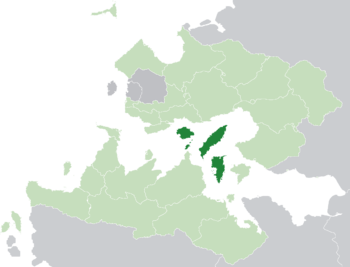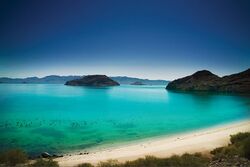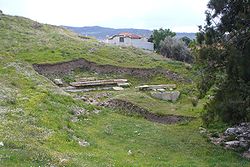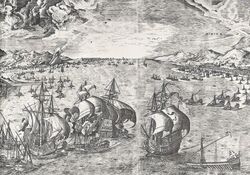Isles of Velar
This article is incomplete because it is pending further input from participants, or it is a work-in-progress by one author. Please comment on this article's talk page to share your input, comments and questions. Note: To contribute to this article, you may need to seek help from the author(s) of this page. |
Kingdom of the Isles of Velar | |
|---|---|
|
Flag | |
 Location of the Isles of Velar (dark green) in the Trellinese Empire (light green) | |
| Capital | Parthenope |
| Largest city | Txir |
| Official languages | Trellinese, Urbont |
| Ethnic groups (2013) | 82.5% Velaric 8.4% Txekri 9.1% others |
| Demonym(s) | Velaran |
| Government | Unitary constitutional monarchy |
• Queen | Azara V |
| Establishment | |
• Foundation | 765 |
• Declaration of Divine Sovereignty | 17 May, 1064 |
• Personal union with Trellin | 1769 |
| Area | |
• Total | 46,206.43 km2 (17,840.40 sq mi) |
| Population | |
• 2013 census | 8,755,823 |
• Density | 189/km2 (489.5/sq mi) |
| Currency | Rasna (Ʀ) (TRS) |
| Time zone | UTC−1 (TCT) |
| Date format | dd/mm/yyyy |
| Driving side | left |
| Calling code | +87585 |
| Internet TLD | .sv |
Velar or the Isles of Velar, officially the Kingdom of the Isles of Velar (Urbont: Risoí Synaxús Velarkon; Trellinese: Demrin Ethka Velari), is a sovereign state and constituent nation of the Trellinese Empire, located in the Sea of Velar in western Astyria. Its landmass of 46,206 square kilometres consists entirely of islands, of which there are 27 larger than 5 square kilometres and five larger than 100 square kilometres in area.
The Isles of Velar are governed by a constitutional monarchy, originally established as an absolute monarchy in 1064 with the Declaration of Divine Sovereignty and reformed following a series of major uprisings in 1536. The country has been in personal union with Trellin since 1769 and it is often considered to be a part of Trellin, though strictly speaking it is only in the Trellinese Empire, not Trellin proper. Its current monarch, since 2015, is Azara V. The capital city is Parthenope, on the island of Napocis, and the largest city is Txir on Semeria.
Name
The name of the kingdom derives from its location in the Sea of Velar. From the 13th to 16th centuries it took the name Kingdom of Velar as it conquered the shores of the Sea of Velar, but when it lost these territories in the 1730s it reverted to its original name.
History
Prehistory
The Velaric culture was one of the first major civilisations to rise in modern Trellin and the Sea of Velar, starting out as small fishing villages around the isles and slowly shifting towards a trading people. By the start of the fifth century BC, the sea was criss-crossed by the trade routes of prosperous Velaric city-states which held shifting allegiances. In contrast to their western counterparts, the eastern Velaric states turned to coastal raiding, waging war on the Perenden civilisation of Andamonia. Baxa was later colonised by the Perendi in their efforts to destroy the Velaric threat.
Middle ages
The Kingdom of the Isles of Velar was founded in 765 by King Szantir I, laying claim to the entire island chain from Napocis in the west to Kerypa in the east, though it only held Napocis and a foothold on Semeria. It spent the next century slowly conquering the Semerian duchies, and their overlord, King Likanton of Txir from 812 onward, was unable to field enough of an army to resist. In 847, he appealed to the Prince of Mora'ika for help, and the resulting alliance engaged the Velaran army at the Battle of Tarm Dolen, near Txir, where it was completely destroyed as a result of a series of miscommunications and poor manoeuvres. The victory left Velar the most powerful nation in the sea, and it began to spread its dominance to the mainlands by colonisation. In the early 900s it conquered the County of Pelna and began making incursions into Retikan territories.
As the Kingdom of Velar attempted to expand along the coasts, other nations in the eastern sea looked on with growing unease. The two most powerful, the Principality of Txekrikar and the Grand Duchy of Ja'ekha, supported by a number of smaller states, entered into a pact against the Velarans in 976. This pact, the Coalition of the East, regularly blocked Velar's attempts at expansion, and, though the numbers of the smaller supporters changed over time, the two central members remained more than a match for Velar on land and often had the manpower to defeat them at sea. From the 1200s on, the Coalition was sponsored by the merchants of Mintra, a Trellinese Trophy Port in the eastern sea which aimed to dominate maritime trade in the region. There were frequent wars, the most disastrous of which culminated in 1481 with the Battle of Mintra, at which nearly two hundred Velaran galleys engaged and destroyed a larger Txekri and Ja'ekhan fleet before going on to sack the port in revenge. The sack of Mintra aroused the ire of the Trellinese Empire, and in 1487 a vast navy was sent out by King Perendur to retaliate against Velar. It destroyed the port of Parthenope before the Velarans had time to assemble their fleets, and the Velaran navy found itself forced to retreat before their larger foe. Storms and minor skirmishes slowly wore down the Trellinese fleet, and they turned north to attack the colonies along the coast of the mainland. Aware that their islands were now safe but unable to attack the Trellinese, the King of Velar agreed to concessions of much of the coast of Pelna and Retikh. Though they continued to colonise in Rezat and Më'idan, the kingdom's northern possessions were whittled away over the following centuries by Trellinese and Ja'ekhan conquests.
Early modern era
The 16th century onward saw the long decline of Velar, and in just two centuries it saw the loss of most of its land north of the Pelnan coast, though it retained a strip with major cities such as Zarthalin, Radulin and Konoros. As its military strength declined, it found itself consorting with its historic rivals in Trellin. In 1737, its young queen, Tarien, married Elcmar, Duke of Palaegon who two years later was crowned King of Trellin. Tarien died suddenly in 1769, sparking fears among the Velaran nobility that, if Elcmar succeeded her, he would name the daughter of his first marriage as his heir to both kingdoms; consequently, they chose a rival candidate for the throne, Prince Miró of Txir, and began the War of the Velaran Succession to protect their monarchy from foreign rule. Velar was at a disadvantage from the outset, but fought a strong resistance to the Trellinese, Arimathean and Ja'ekhan coalition that formed against them. After the Siege of Teyra, Miró capitulated and recognised Elcmar's accession to the throne.
Geography

Major islands:



